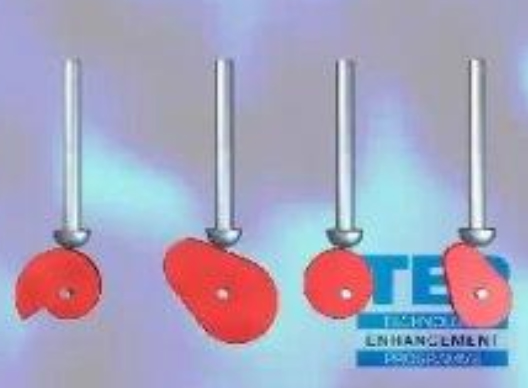Camau
Cams
Mecanwaith cam a dilynwr yw siâp proffil wedi ei fowntio ar siafft sy’n achosi i lifer neu ddilynwr symud. Defnyddir camau i drawsnewid mudiant cylchol yn fudiant llinol (cilyddol). Wrth i’r cam gylchdroi, mae’r dilynwr yn codi a disgyn mewn proses a elwir yn fudiant cilyddol. Caiff mudiant y dilynwr ei gyfyngu i batrwm sydd eisoes wedi ei bennu gan ganllaw. Mae’r dilynwr yn cadw cysylltiad â’r cam trwy rym disgyrchiant neu sbring. Strôc yw’r term a ddefnyddir am amrediad cyfan y symudiad a gynhyrchir gan y cam. Bydd amrediad symudiad y dilynwr yn dibynnu ar y pellter rhwng y siafft sy’n cynnal y cam a’r pwyntiau uchaf ac isaf ar gylch y cylchdro. Defnyddir camau yn aml mewn peiriannau i reoli falfiau (a’r falf yw’r dilynwr), peiriannau gwnïo, teganau plant a nifer o ddyfeisiau mecanyddol eraill.

Caiff siapiau camau unigol eu dylunio er mwyn cynhyrchu mathau penodol o fudiant.
Ceir camau mewn amrywiaeth o siapiau a meintiau – dyma’r mathau mwyaf cyffredin (o’r chwith i’r dde): siâp malwen, siâp gellygen a siâp cylch gyda thwll nad yw yn y canol. Wrth i’r camau gylchdroi, mae’r dilynwyr yn cilyddu’r mudiant yn ôl proffil pob cam. Er enghraifft, bydd camau siâp gellygen yn achosi’r dilynwr i godi, disgyn ac yna oedi, cyn ailadrodd y weithred. Bydd camau siâp cylch, a elwir weithiau yn gamau echreiddig, yn achosi symudiad codi a disgyn llyfn heb unrhyw saib. Gelwir hyn yn weithred harmonig. Rhaid ystyried nifer o bethau pan fyddwch yn defnyddio cam a dilynwr. Fel arfer, rhaid cadw siafft y lifer mewn cysylltiad â’r cam; gall defnyddio dilynwr rholer helpu gyda hyn. Rhaid iro’r arwynebau llithro’n dda hefyd, er mwyn lleihau traul.
Model o gam a dilynwr.
Caiff y dilynwr ei ddal yn erbyn y cam gan ei bwysau ei hun.Wrth i’r cam gylchdroi, mae’r dilynwr yn symud i fyny ac i lawr mewn mudiant cilyddol.
A cam and follower mechanism is a profiled shape mounted on a shaft that causes a lever or follower to move. Cams are used to convert rotary to linear (reciprocating) motion. As the cam rotates, the follower rises and falls in a process known as reciprocating motion. The motion of the follower is restricted to a pre-determined pattern by a guide. The follower maintains contact with the cam through the force of gravity or by a spring. The total range of movement produced by the cam is called the stroke. The range of movement of the follower will depend on the distance from the shaft supporting the cam to the upper and lower points of the rotation circle. Cams are commonly used in engines to control valves (in which the valve is the follower), sewing machines, children's toys and many other mechanical applications.

The shape of individual Cams are designed to produce specific types of motion.
Cams come in a variety of shapes and sizes - the most common types (from left to right): snail shaped, pear shaped and a circular with an off-centre hole. As the cams rotate, the followers reciprocate motion according to the profile of each cam. For example, cams that have a pear shape will cause the follower to lift, to fall and then to pause before repeating the action. Cams that have a circular shape, sometimes referred to as eccentric cams, will cause a smooth rise and fall movement with no pause. This is known as harmonic action. Whenever using a cam and follower, several considerations need to be taken. The lever shaft usually has to be kept in contact with the cam; using a roller follower can assist this. The sliding surfaces must also be kept well lubricated to reduce wear.
Model of a cam and follower.
The follower is held against the cam by its own weight. As the cam rotates the follower moves up and down in a reciprocating motion.



